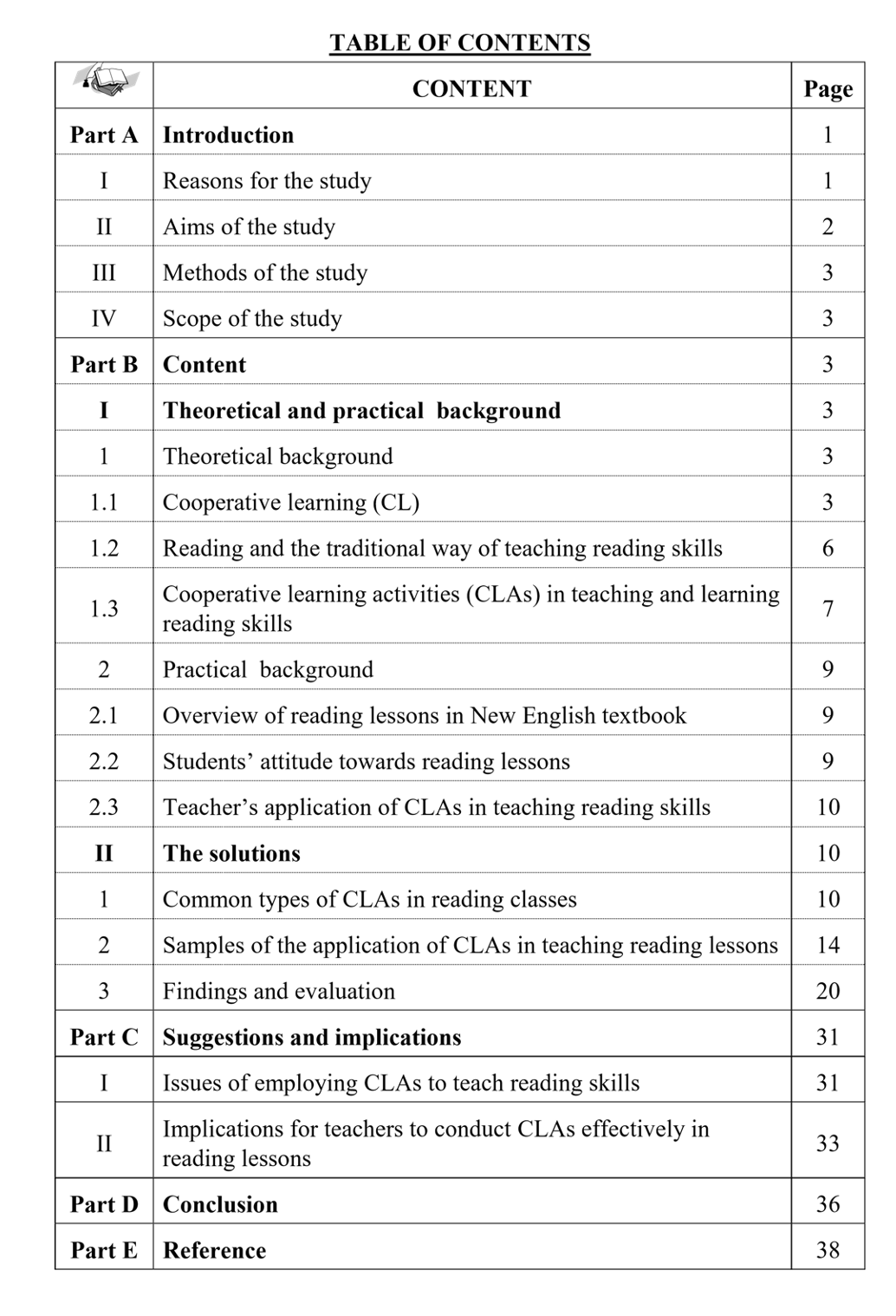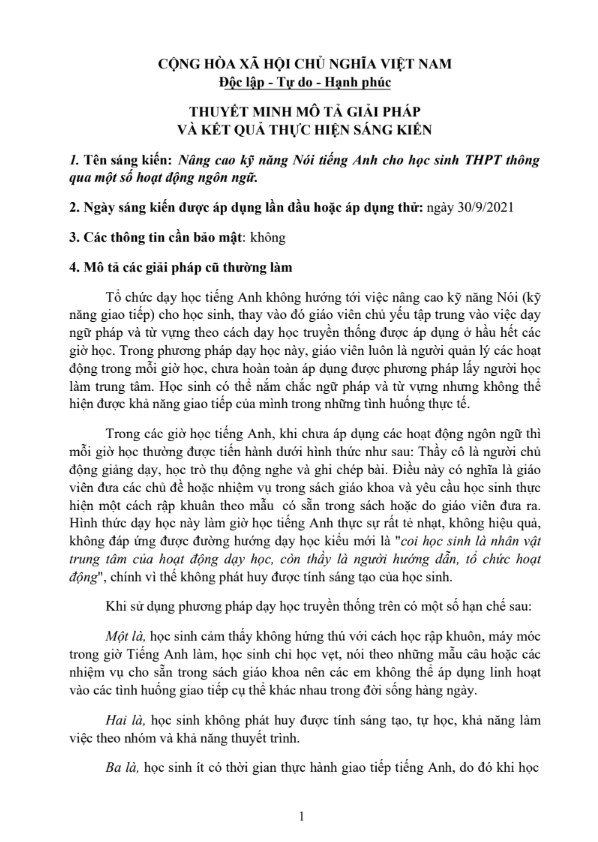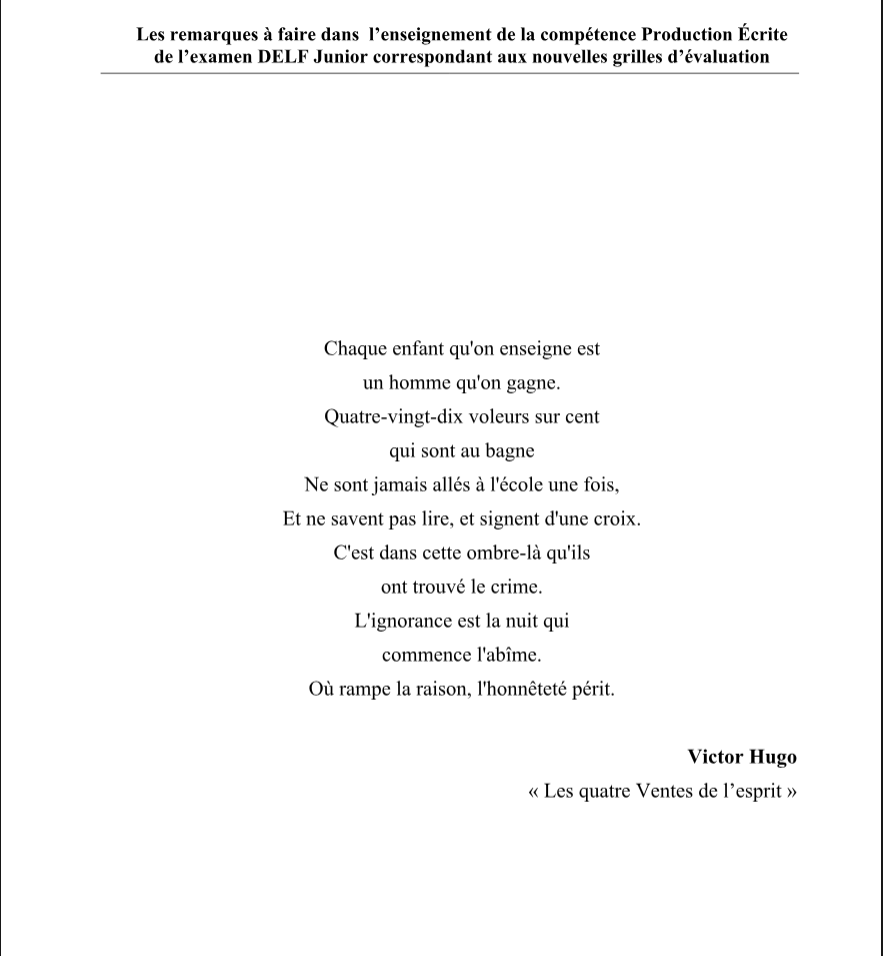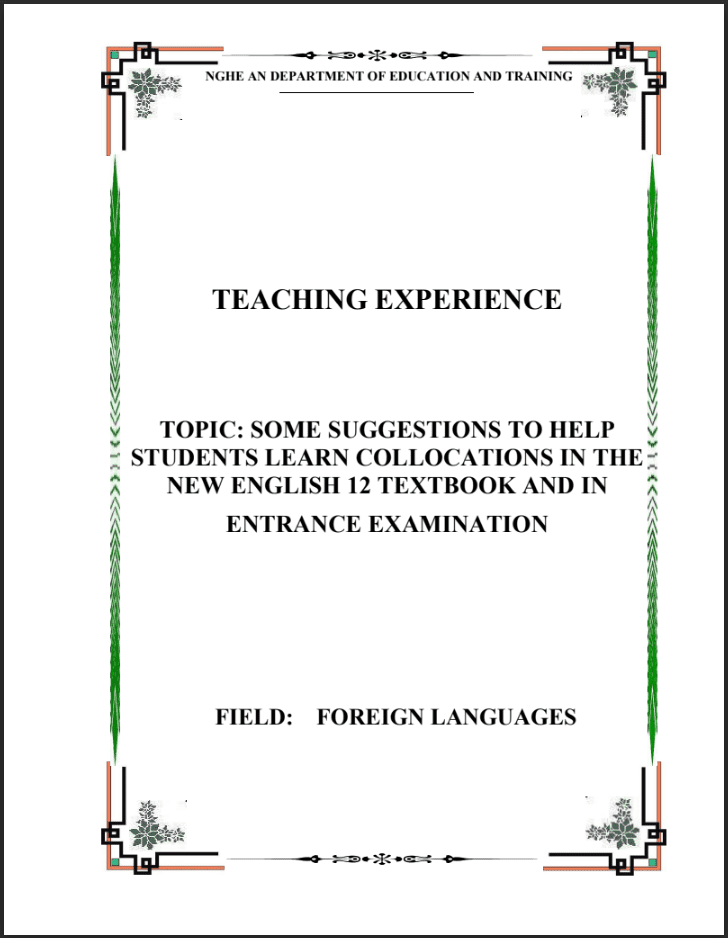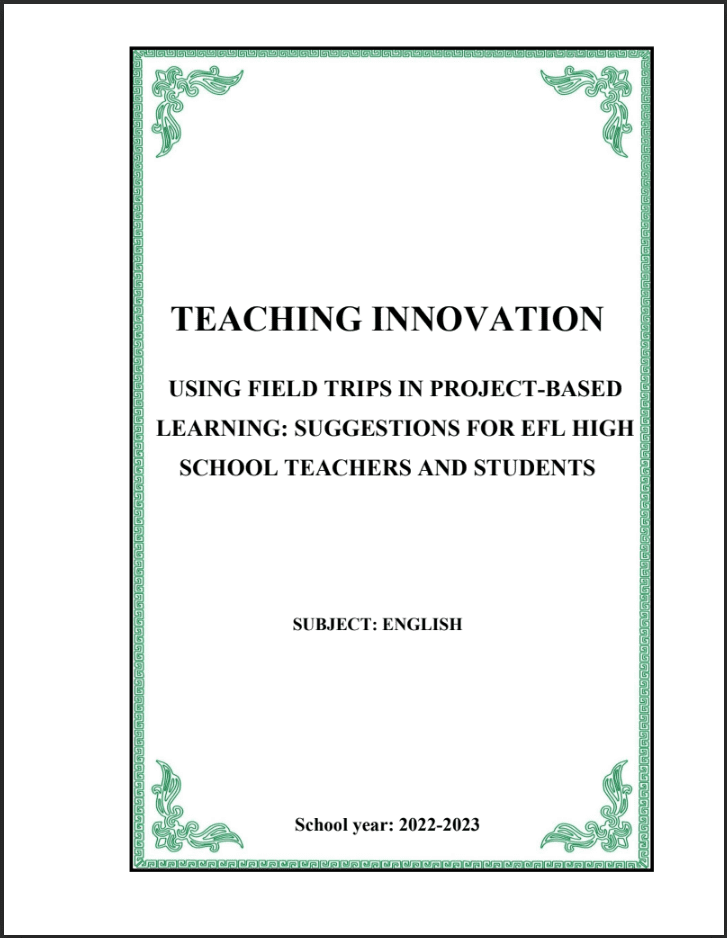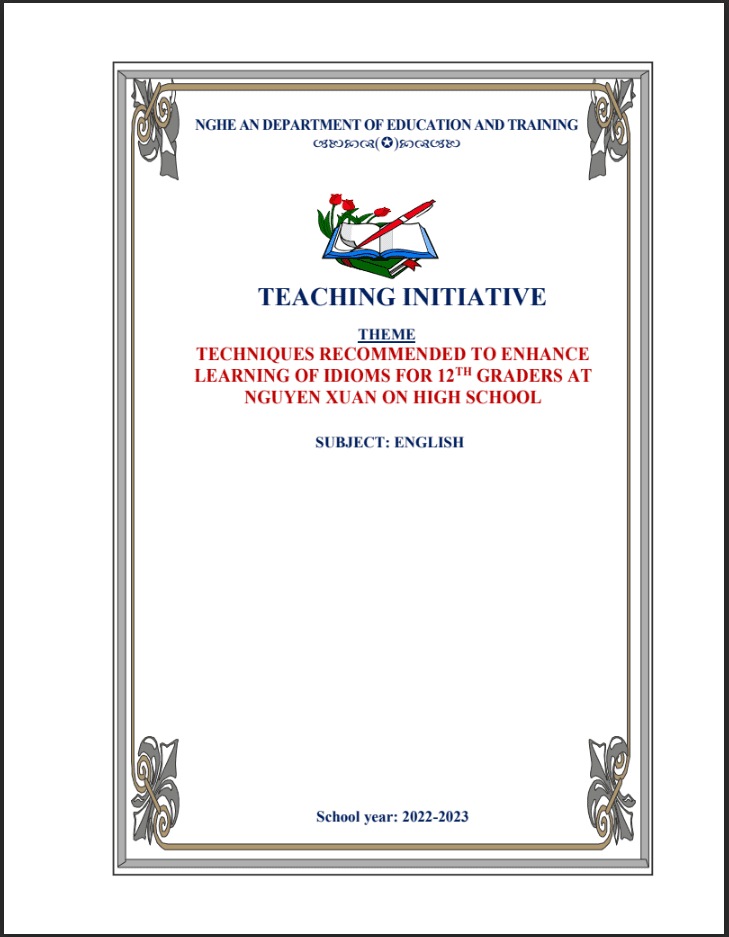SKKN Applying Cooperative Learning Activities (CLAs) to improve students’ reading skills in high school
- Mã tài liệu: MP0030 Copy
| Môn: | Tiếng anh |
| Lớp: | 10, 11 |
| Bộ sách: | |
| Lượt xem: | 981 |
| Lượt tải: | 11 |
| Số trang: | 40 |
| Tác giả: | Bùi Thị Mỹ Hảo |
| Trình độ chuyên môn: | Thạc sĩ giáo dục |
| Đơn vị công tác: | THPT Đô Lương 2 |
| Năm viết: | 2021-2022 |
| Số trang: | 40 |
| Tác giả: | Bùi Thị Mỹ Hảo |
| Trình độ chuyên môn: | Thạc sĩ giáo dục |
| Đơn vị công tác: | THPT Đô Lương 2 |
| Năm viết: | 2021-2022 |
Sáng kiến kinh nghiệm “SKKN Applying Cooperative Learning Activities (CLAs) to improve students’ reading skills in high school” triển khai gồm các biện pháp nổi bật sau:
1. Common types of CLAs in reading classes
1.1. Jigsaw Activity
1.2. Paired Reading
1.3. Self-Generated Questions
1.4. Group Summarization
1.5. Think-Aloud
1.6. Cooperative Integrated Reading and Composition (CIRC)
2. Samples of the application of CLAs to teach reading lessons in New English Textbook in high school
3. Finding and Evaluation
Mô tả sản phẩm
PART A: INTRODUCTION
I. Reasons for the study
Currently, English has become the most popular language all over the world and it is considered as the officially international language. Although English is not the largest number of native or first language speakers, it is widely used by many people as their second language to communicate with others from different cultures. In addition, English is an important language for all kinds of professional and personal goals. Its importance in the global market place cannot be understated. Learning English really can change your life. Although learning English can be challenging and time consuming, we can see that it is also very valuable to learn and can create many opportunities, especially for the young. Because of its essential role, English has not only been gradually taught in every school from primary level to higher education but also become the core and compulsory subject in the National Examinations in Viet Nam and many different countries in the world. With such a trend of development, learning English is important than ever before.
Among four language skills, reading is considered the most crucial of the primary abilities required for a student to be an effective English communicator. However, many Vietnamese high school students regard reading as the most boring and difficult one. The reason behind this is that, in Vietnamese classrooms, teaching English reading skills to high school students is still controlled by the teacher-centered approach. Specifically, in a typical English reading lesson, the reading process occurs repeatedly as the teacher asks students to read the entire passage, answer a few questions, or complete some reading comprehension exercises available in the textbook. The main task for the students is to read over and over again until they understand the passage thoroughly and complete all the textbook tasks. This method of teaching and learning easily makes students find reading lessons monotonous and depressing, especially for weak students. They often feel stressed while learning and neglect the lessons. As a result, the majority of students find it difficult and challenging to make good progress in this skill. To make reading more dynamic, engaged, and productive process, more emphasis should now be placed on communication and interaction in reading classrooms to compensate for this issue. In this spirit, developing students’ cooperative and supportive skills to work together in reading classes becomes a demand.
Unlike grammar-based approach, communicative language teaching (CLT) method covers the training of all four core skills: listening, speaking, reading, and writing. And the success of communicative English instruction through this approach hinges entirely on the practice of these skills. To achieve this, it is now necessary to take into consideration the application of a typical technique of CLT, the cooperative learning (CL), for its utility in encouraging students from diverse groups to cooperate and support one another, as well as assist teachers in overcoming the difficulties in teaching method and organizing classroom activities. CL is described as a broad category of instructional practices in which students collaborate in order to achieve a common goal. Its effectiveness has been well documented and now widely recognized as one of the most promising practices in educational field. CL proves to be a successful teaching technique at all levels, from pre-school to post-secondary education, and as a peer-centered pedagogy that can promote academic achievements and build positive social relationships. As a result, it is reasonable to believe that CL provides a supportive atmosphere for both the best and the least capable students to practice English, as well as a tool to help Vietnamese students reach their goal of becoming competent English communicators.
Having applied cooperative learning activities (CLAs) in reading lessons for 11th graders, I find that my students have studied more actively and effectively. They are more excited to access the reading lessons. They no longer feel stressful and bored during classes. Majority of students after involving in these activities admit that CLAs have positive effect on their language competence in general and reading skills in particular, especially in terms of broadening their vocabulary and helping them use appropriate strategies to access the reading text. Therefore, the effectiveness of the lessons are much higher. In addition to this, these activities also develop necessary soft skills for students such as interaction, collaboration, sense of responsibility and autonomy in learning. As an English teacher, I truly believe that this study would be a great contribution to my current teaching.
I would like to recommend some CLAs in teaching English so that my colleagues can apply them to improve their students’ learning process. The topic is “Applying Cooperative Learning Activities (CLAs) to improve students’ reading skills in high school”.
To be honest, there are inevitable shortcomings and mistakes in my study in such limited time. I am glad to have more constructive opinions and helpful supports from my colleagues so that it will be more perfect and applicable.
II. Aims of the study
The aims of this study are:
- To give a brief overview on CLAs and introduce samples of helping improve students’ reading skills through these activities in reading lessons
- To increase students’ creativity and autonomy in learning language
- To help students learn in free and flexible ways
- To boost students’ confidence and help develop a learner-centered dynamic
- To create a friendly and supportive learning environment
- To examine the effects of CLAs activities on 11th graders’ reading skill
- To suggest some solutions for teachers’ application to utilize CLAs to enhance their students’ language learning abilities in general and students’ reading skill in particular
- To raise students’ awareness of cooperating and supporting each others during the lessons
III. Methods of the study
- Base on my personal teaching experience
- Study a variety of documents and share experience with my colleagues
- Design two reading test (pre-test and post-test) before and after applying the method to confirm the result
- Carry out surveys among students of the two experimental classes after applying the method about the effectiveness of the application
- Conduct an interview with 5 students from the two experimental classes after applying the method to get a deeper insight of the benefits and also the challenges of the method
- Apply and adapt some essential knowledge from the workshops and classes I have participated in before
- Scope of the study
Students at Quynh Luu 3 High school.
PART B: CONTENT
I. THEORETICAL AND PRACTICAL BACKGROUND 1. Theoretical background
1.1. Cooperative Learning
1.1.1. Definition of Cooperative Learning
Slavin (1992), one of the founders of CL, states that CL refers to instructional methods involving small heterogeneous group working together, usually toward a common goal. Kagan (1988) describes cooperative work as a task that is accomplished by dividing it among participants, where each person is responsible for a portion of the problem solving.
1.1.2. Cooperative Learning vs. Group Learning
Traditionally, high school teachers group students by putting four or five students in a row in class and asking them to complete a task without further assistance or careful organization. In fact, tasks need to be planned to ensure
TÀI LIỆU LIÊN QUAN
- 7
- 105
- 1
- [product_views]
- 5
- 173
- 2
- [product_views]
- 4
- 165
- 3
- [product_views]
- 4
- 129
- 4
- [product_views]
100.000 ₫
- 6
- 434
- 5
- [product_views]
100.000 ₫
- 2
- 507
- 6
- [product_views]
100.000 ₫
- 9
- 546
- 7
- [product_views]
100.000 ₫
- 4
- 409
- 8
- [product_views]
100.000 ₫
- 2
- 595
- 9
- [product_views]
100.000 ₫
- 0
- 538
- 10
- [product_views]

